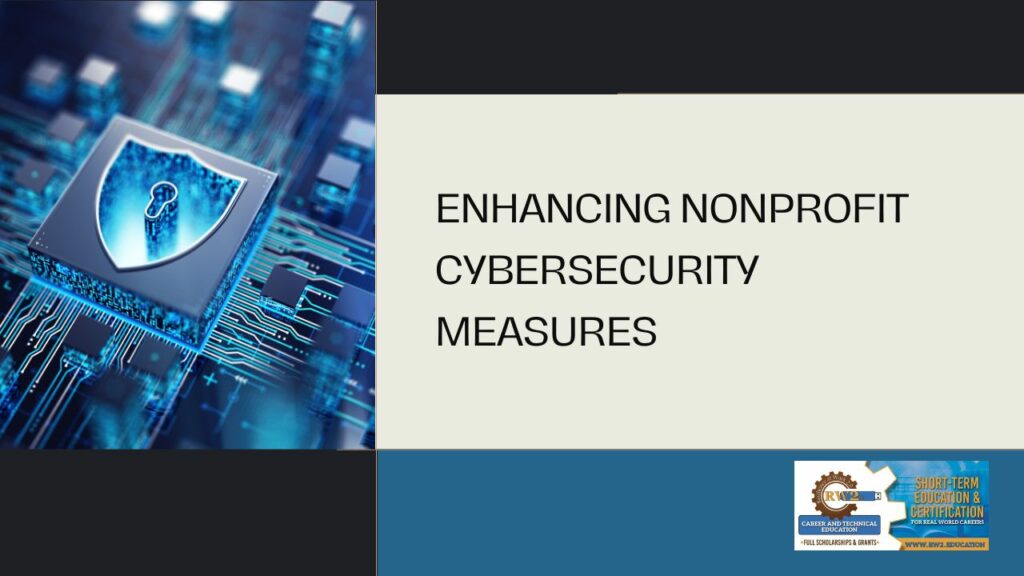
Welcome to our blog post on cybersecurity for nonprofits. As we become more reliant on technology, the threat of cyber attacks and data breaches continues to grow. And while many may think that cyber threats only target large companies or government organizations, the truth is that small businesses and nonprofits are just as vulnerable.
In fact, nonprofits are often prime targets for cybercriminals due to their sensitive data and limited resources for cybersecurity. In this post, we’ll delve into the importance of cybersecurity for nonprofits, share real-life examples of data breaches in the nonprofit sector, and provide best practices to help you strengthen your organization’s cyber defenses.
So, let’s arm ourselves with knowledge and take action to protect our nonprofits from cyber threats.
Why Nonprofits Are Prime Targets for Cyber Attacks
Nonprofits might not seem like the typical target for cybercriminals at first glance, but a closer look reveals why they’re particularly vulnerable.
First off, many nonprofits handle a treasure trove of sensitive information, including donor details, financial records, and the personal data of beneficiaries. This makes them as rich in valuable data as any for-profit entity.
Secondly, due to budget constraints, cybersecurity might not top the priority list for many nonprofit organizations. This often leads to outdated systems, a lack of proper cybersecurity training for staff, and insufficient protective measures, making them an easier target compared to well-defended corporations.
Additionally, the trusting nature of the nonprofit sector, where sharing and collaboration are encouraged, can sometimes lead to a false sense of security and an underestimation of cyber threats.
All these factors combined make nonprofits an attractive target for cybercriminals looking for easier access to sensitive data. Recognizing this vulnerability is the first step in fortifying defenses and keeping the valuable work of nonprofits safe from harm.
The Harsh Reality: Notable Nonprofit Data Breaches
The digital landscape is fraught with dangers, and the nonprofit sector is not immune to these threats. The incidents of cyberattacks on nonprofits are not just hypothetical scenarios but harsh realities that have already unfolded, causing significant distress and damage.
These breaches not only jeopardize the sensitive information of donors and beneficiaries but also tarnish the reputation and trust that nonprofits work so hard to build. Understanding these real-life examples can be a sobering reminder of the importance of cybersecurity in safeguarding the mission and integrity of nonprofit organizations.
One notable breach occurred at the American Red Cross, where an unauthorized party gained access to the personal information of over 515,000 blood donors due to a vulnerability in a third-party service provider’s system.
This breach exposed sensitive data, including contact information and health histories, highlighting the risks associated with third-party vendors.
Similarly, Save the Children fell victim to a sophisticated email scam, leading to the loss of $1 million. Cybercriminals used a compromised email account to pose as a staff member, initiating fraudulent transactions under the guise of legitimate operations.
In another instance, the Utah Food Bank suffered a security breach where hackers infiltrated their systems and potentially accessed the personal information of thousands of donors. This attack underlines the critical need for robust cybersecurity measures to protect against unauthorized access to sensitive data.
These incidents serve as stark reminders of the vulnerabilities that exist within the nonprofit sector and the devastating impact a breach can have. By examining these examples, nonprofits can better understand the threats they face and the importance of implementing comprehensive cybersecurity strategies to protect against them.
The Domino Effect of a Data Breach on Nonprofits
When a data breach occurs in a nonprofit organization, it’s not just a one-time incident; it initiates a cascade of consequences that can deeply affect the organization’s operations, reputation, and trustworthiness.
Imagine the ripple effects as the news of the breach spreads. Donors, who are the lifeline of nonprofit funding, may start to question the security of their personal and financial information, potentially leading to a decrease in donations.
This financial hit can stifle the nonprofit’s ability to serve its mission, impacting the very communities and individuals it aims to help.
Moreover, the resources required to address the breach—from legal fees and regulatory fines to the cost of improving cybersecurity measures—can further divert funds away from programmatic work. The time and energy spent managing the fallout from a breach also detract from the nonprofit’s core activities, leading to lost opportunities and possibly even jeopardizing future projects.
The domino effect continues as the breach could damage the organization’s reputation, making it harder to attract new donors, volunteers, and even staff. Restoring trust becomes a long-term challenge, requiring transparent communication and demonstrable changes in data protection practices.
This journey to rebuild confidence and secure operations again underscores why proactive cybersecurity measures are not just advisable but essential for nonprofits.
Simple Yet Effective Cybersecurity Best Practices for Nonprofits
Strengthening your nonprofit’s cyber defenses doesn’t have to be a daunting task. By implementing simple yet effective cybersecurity best practices, you can significantly reduce your organization’s risk of falling victim to cyberattacks. Here are some actionable steps to get you started:
Educate Your Team
The first line of defense against cyber threats is a well-informed team. Provide regular training sessions on recognizing phishing emails, the importance of strong passwords, and safe internet practices. Encourage a culture where staff feel comfortable reporting potential security threats.RW2 offers Cybersecurity programming that spans just 24 weeks. The knowledge and skills gained support monitoring, defending, and safeguarding against cyber threats. By completing this course, you will be better equipped to protect sensitive data and maintain organizational security.
Update and Patch Regularly
Ensure that all systems and software are kept up-to-date with the latest security patches. Hackers often exploit vulnerabilities in outdated software, so regularly scheduled updates can close these loopholes.
Implement Strong Access Controls
Not everyone in your organization needs access to all the information. Use the principle of least privilege (PoLP) and give individuals access only to the data and systems necessary for their roles. Additionally, enable multi-factor authentication (MFA) to add an extra layer of security.
Back Up Your Data
Regular backups of critical data can be a lifesaver in the event of a cyberattack. Make sure these backups are encrypted and stored securely, preferably offsite, on an external hard drive, or in a cloud service designed for secure storage.
Secure Your Networks
Use firewalls and encryption to secure your organization’s network. Consider a virtual private network (VPN) for remote access to ensure that connections are safe and secure.
Work with Trusted Vendors
When outsourcing IT services or working with third-party vendors, ensure they adhere to strict cybersecurity standards. Their security practices should be thoroughly vetted, as their vulnerabilities can become your vulnerabilities.
By focusing on these key areas, nonprofits can create a robust cybersecurity framework that guards against the majority of cyber threats. Remember, the goal is not just to protect your organization but also to preserve the trust of those you aim to serve.
Implementing these practices demonstrates a commitment to cybersecurity that can reassure donors, beneficiaries, and staff alike.
Level Up Your Cybersecurity Skills to Protect Your Nonprofit
In today’s digital world, enhancing your cybersecurity skills is more crucial than ever, especially for those working in the nonprofit sector. Recognizing this, RW2 Career and Technical Education (RW2) offers a comprehensive Cybersecurity training that can help bolster your defenses against cyber threats.
This class unfolds over 24 weeks and is conveniently offered in the day from 9:00 am – 12:30 pm or evenings from 6:00 pm to 9:30 pm, three days per week and all online. This flexibility ensures that even busy individuals can find a schedule that fits.
Understanding the financial constraints often faced by individuals in the nonprofit sector, RW2 provides no interest payment plan options for both international and US students, allowing up to 6 months for international students and up to 10 months for US students. This approach ensures that financial barriers do not hinder your ability to secure and protect your organization’s valuable data.
The curriculum is meticulously designed to empower you with a comprehensive understanding of information security. Throughout the course, you’ll delve into using Python for developing security tools and automating tasks, grasp network basics and network security, and learn to identify and mitigate various cyber threats, vulnerabilities, and attacks.
The inclusion of a gap analysis capstone project allows you to apply what you’ve learned in a real-world context, showcasing your skills and experience to identify and mitigate risks. Additionally, the course aligns with preparing you for CompTIA’s Security+ certification exam, an industry recognized credential among employers and cybersecurity professionals, though taking the exam is optional for completing the program.
Soft skills, such as teamwork and business ethics, are also emphasized, ensuring you’re not just technically adept but also well-rounded in essential workplace skills. This is complemented by job search skills from resume updates to interview skills to job referrals.
The Missouri Department of Higher Education and Workforce Development has certified RW2, ensuring the caliber and reliability of your educational experience.
Furthermore, for those looking to further their education, RW2 has an articulation agreement with Avila University in Kansas City, MO, allowing the transfer of up to 12 credits from the Cybersecurity program.
By enrolling in RW2’s Cybersecurity class, you’re investing in your professional growth and contributing significantly to the security and trustworthiness of the vital services your organization provides.
The Road Ahead: Creating a Culture of Cybersecurity Awareness
As we navigate the digital age, the importance of fostering a culture of cybersecurity awareness cannot be overstated. It begins with each of us as individuals, recognizing that our actions contribute to the safety and integrity of the nonprofits we are part of.
Embracing a mindset where cybersecurity becomes an integral aspect of our daily routines is crucial. This means staying curious and informed about the latest cyber threats and protective measures, and proactively sharing this knowledge within and among our networks. If you would like RW2 to assist your nonprofit organization in getting started, please contact us at 816-875-0111 or email us at rw2.cte.rw2.education. We’re happy to have a short conversation with you and share a simple checklist of things you can and should do NOW to help protect yourself and your organization.
By promoting cybersecurity in our individual roles, we help to create a larger culture of security that not only protects our data but also upholds the trust of those we serve.




Temp mail I like the efforts you have put in this, regards for all the great content.
Thank you so much for your kind words and appreciation. It means a lot to know that the content resonates with you. If there’s anything specific you’d like to see more of or any feedback you have, feel free to share!
Tech to Force This was beautiful Admin. Thank you for your reflections.
Thank you so much for your kind words! I’m really glad that the reflections resonated with you. Cybersecurity is such a crucial topic, especially for nonprofits that handle sensitive data and often have limited resources to protect it. It’s wonderful to know that the piece was both informative and meaningful to you. Your feedback truly motivates us to continue exploring important issues like this. Thanks again for reading and sharing your thoughts!